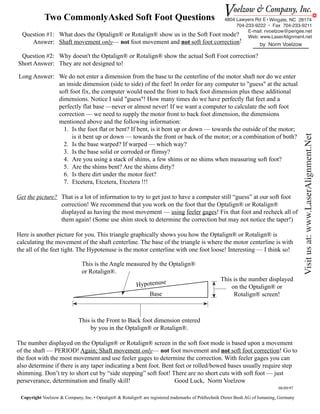
Soft Foot
- 1. Two CommonlyAsked Soft Foot Questions Voelzow & Company, Inc. 4804 Lawyers Rd E • Wingate, NC 28174 704-233-9222 • Fax 704-233-9211 E-mail: nvoelzow@perigee.net Question #1: What does the Optalign® or Rotalign® show us in the Soft Foot mode? Web: www.LaserAlignment.net Answer: Shaft movement only— not foot movement and not soft foot correction! by Norm Voelzow Question #2: Why doesn't the Optalign® or Rotalign® show the actual Soft Foot correction? Short Answer: They are not designed to! Long Answer: We do not enter a dimension from the base to the centerline of the motor shaft nor do we enter an inside dimension (side to side) of the feet! In order for any computer to "guess" at the actual soft foot fix, the computer would need the front to back foot dimension plus these additional dimensions. Notice I said "guess"! How many times do we have perfectly flat feet and a perfectly flat base —never or almost never! If we want a computer to calculate the soft foot correction — we need to supply the motor front to back foot dimension, the dimensions mentioned above and the following information: 1. Is the foot flat or bent? If bent, is it bent up or down — towards the outside of the motor; Visit us at: www.LaserAlignment.Net is it bent up or down — towards the front or back of the motor; or a combination of both? 2. Is the base warped? If warped — which way? 3. Is the base solid or corroded or flimsy? 4. Are you using a stack of shims, a few shims or no shims when measuring soft foot? 5. Are the shims bent? Are the shims dirty? 6. Is there dirt under the motor feet? 7. Etcetera, Etcetera, Etcetera !!! Get the picture? That is a lot of information to try to get just to have a computer still “guess” at our soft foot correction! We recommend that you work on the foot that the Optalign® or Rotalign® displayed as having the most movement — using feeler gages! Fix that foot and recheck all of them again! (Some use shim stock to determine the correction but may not notice the taper!) Here is another picture for you. This triangle graphically shows you how the Optalign® or Rotalign® is calculating the movement of the shaft centerline. The base of the triangle is where the motor centerline is with the all of the feet tight. The Hypotenuse is the motor centerline with one foot loose! Interesting — I think so! This is the Angle measured by the Optalign® or Rotalign®. This is the number displayed Hypotenuse on the Optalign® or Base Rotalign® screen! This is the Front to Back foot dimension entered by you in the Optalign® or Rotalign®. The number displayed on the Optalign® or Rotalign® screen in the soft foot mode is based upon a movement of the shaft — PERIOD! Again; Shaft movement only— not foot movement and not soft foot correction! Go to the foot with the most movement and use feeler gages to determine the correction. With feeler gages you can also determine if there is any taper indicating a bent foot. Bent feet or rolled/bowed bases usually require step shimming. Don’t try to short cut by “side stepping” soft foot! There are no short cuts with soft foot — just perseverance, determination and finally skill! Good Luck, Norm Voelzow 08/09/97 Copyright Voelzow & Company, Inc. • Optalign® & Rotalign® are registered trademarks of Prüftechnik Dieter Bush AG of Ismaning, Germany
- 2. Voelzow & Company, Inc. 4804 Lawyers Rd E • Wingate, NC 28174 TYPICAL CAUSES OF SOFT FOOT 704-233-9222 • Fax 704-233-9211 E-mail: nvoelzow@perigee.net (also known as Short Leg, Spring Foot, Rubber Leg) Web: www.LaserAlignment.net by Bev Voelzow 1. "Short-Leg" ss ce nt x e fe of ignm im l Tr ter a af Visit us at: www.LaserAlignment.Net Tilted Leg 2. Step shims • Angled Pad 3. • Bowed Baseplate "Deck of Cards" 4. • Too Many Shims • Dirty Shims • Shims with Burrs • Bent Shims • Rough/Dirty Surfaces 5. • Oversized Shims/Long Pads Copyright Voelzow & Company, Inc. • Optalign® & Rotalign® are registered trademarks of Prüftechnik Dieter Bush AG of Ismaning, Germany